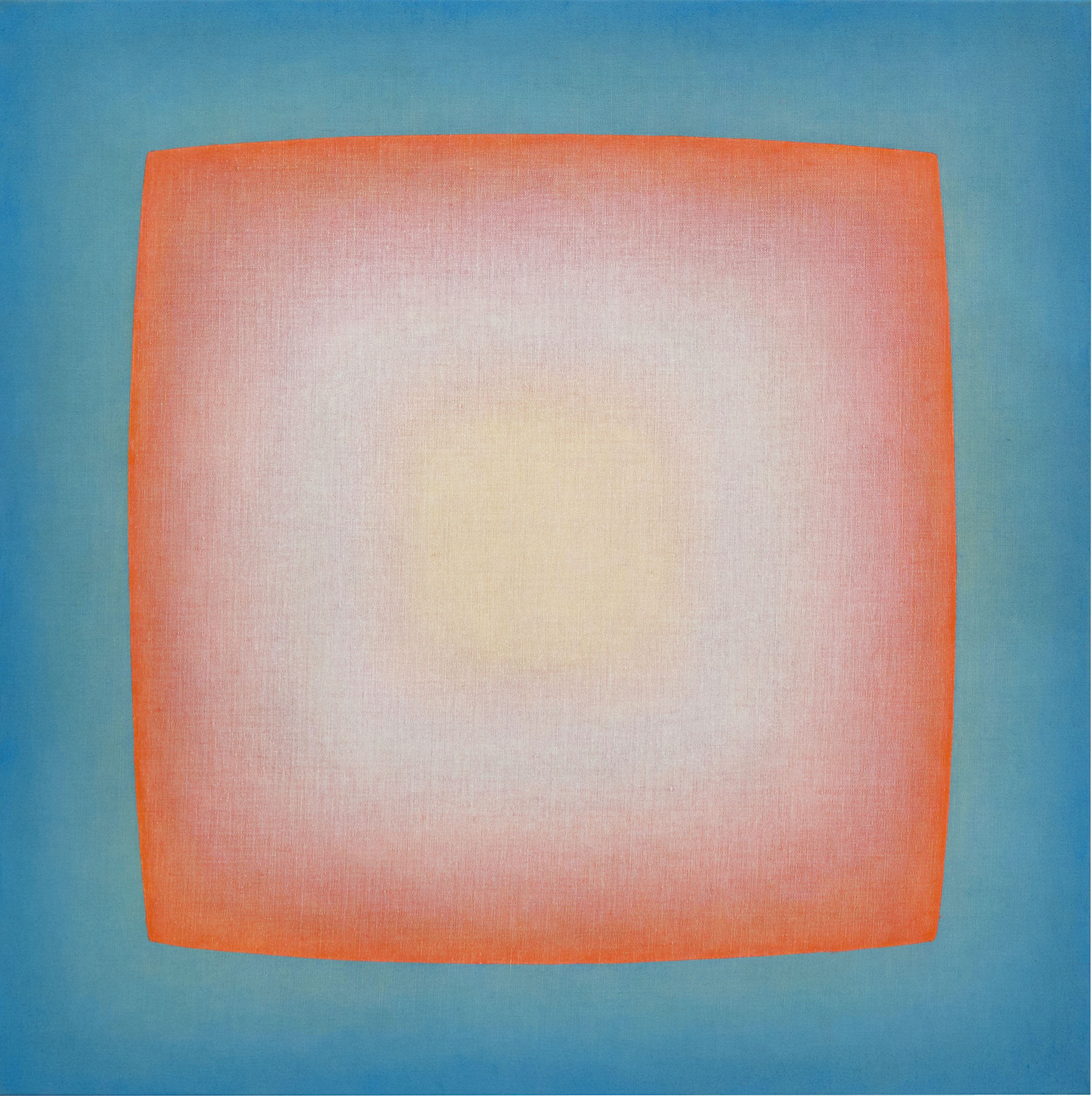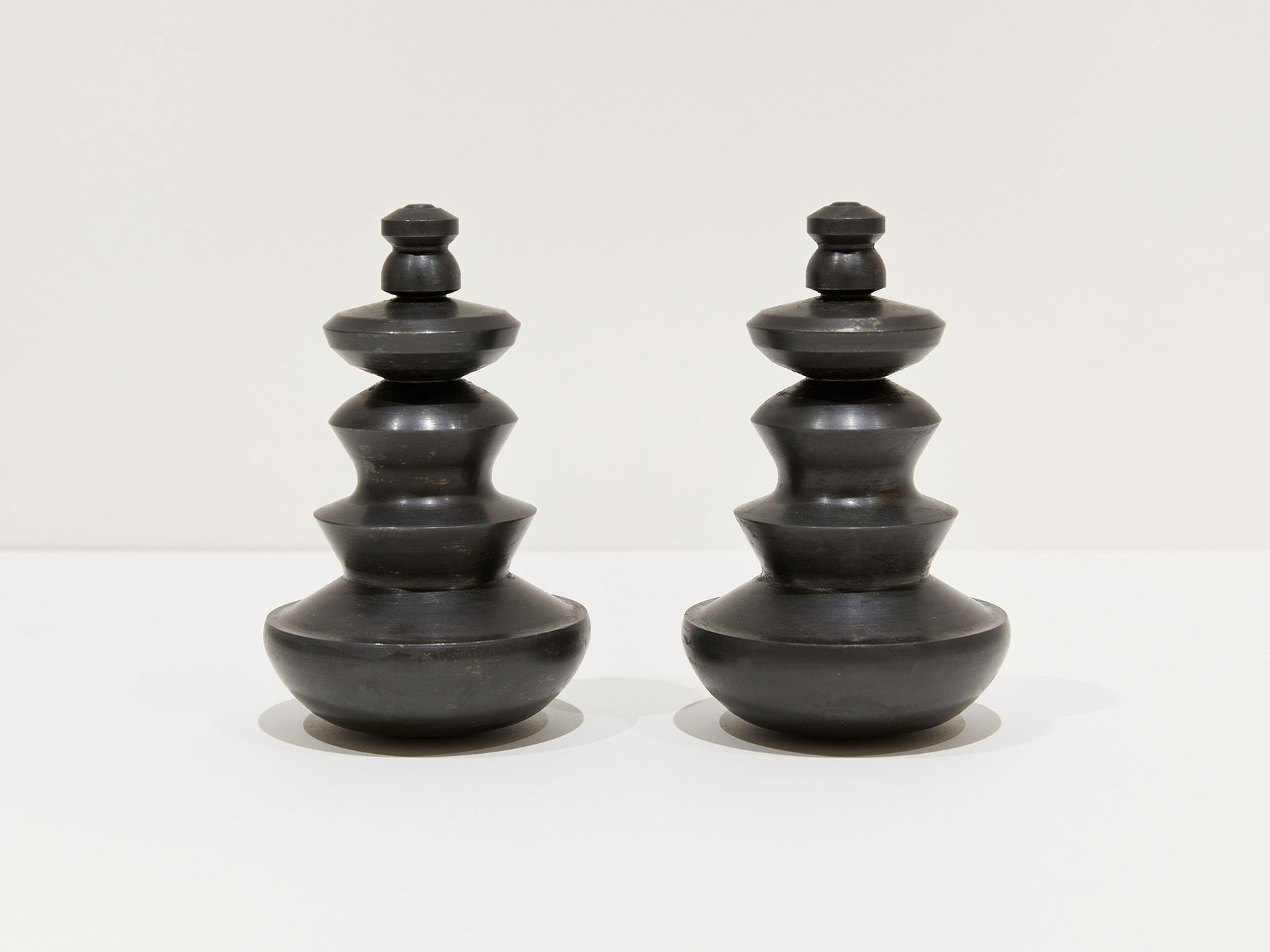
Chen Ruo Bing und Abraham David Christian
Eröffnung
Freitag, 19. September von 19 – 21 Uhr
Chen Ruo Bing und Abraham David Christian verfolgen in ihrer Arbeit jeweils ein Ziel, das sie nie erreichen und das sie immer wieder neu herausfordert. Es lässt sich nicht in Worte fassen. Der Text kann beschreiben und versuchen, sich anzunähern. Erfassen lassen sich die Werke jedoch nur im Betrachten.
Das Werk von Chen Ruo Bings teilt sich in zwei Gruppen auf: 1. Das sich an allen Seiten leicht konvex wölbende Quadrat auf dem Grund der quadratischen Leinwand. Diese Bilder gibt es in klein (20 x 20 cm) bis groß (200 x 200 cm). 2. Das schmale Längsformat mit frei schwebendem, dreidimensional erscheinendem Stab in Bildlänge. Auch diese Bilder gibt es in unterschiedlichen Längen und Breiten, von 110 cm bis 300 cm Länge. Wir zeigen in der Ausstellung sowohl quadratische Bilder als auch Längsformate.
In den quadratischen Bildern arbeitet der Künstler mit Farbkontrasten. Das in der Mitte schwebende, sich wölbende Quadrat hat helle und dunkle Bereiche, es kann sich nicht nur in der Form, sondern auch in der Farbe deutlich vom Untergrund abheben und vielfarbig oder einfarbig sein. Es kann sich auch mit hellen und dunklen Schattierungen an die Untergrundfarbe angleichen. Das Grundprinzip ist unendlich wandelbar. Die Längsformate haben horizontale Farbverläufe. Sie lassen an Landschaften denken, an Blicke auf Meer und Himmel bei wechselnden Lichtverhältnissen. Der schwebende, dreidimensionale Stab widerspricht jedoch dem Landschaftsgedanken, auch diese Bilder sind abstrakt zu lesen als Darstellungen von Farbe und Licht. Die Struktur von Farbe und Leinwand lässt sich durch den bewusst dünnen Farbauftrag hindurch erkennen – als Licht, das alles zum Leuchten bringt. So lässt sich Chen Ruo Bings Bestreben vielleicht zusammenfassen.
Die Eisenskulpturen von Abraham David Christian werden in einem aufwändigen Verfahren aus massiven Eisentrommeln gedreht. Ein Prozess, der bis zu einem Jahr dauern kann. Sie sind 14 bis 20 cm hoch und haben einen Durchmesser von 8 bis 10 cm. Es scheint als fügten sie sich aus Modulen zusammen, die aus einer runden Ausgangsform entwickelt wurden. In jeder Skulptur werden sie neu zusammengesetzt und variiert. Die fünf Skulpturen, die wir in der Ausstellung zeigen, ähneln und unterscheiden sich. Ihr Aufbau lässt an eine menschliche Figur oder ein Gefäß denken. Sie haben unten eine breite Grundfläche, nach oben hin werden sie schmaler, das Abschlussmodul hat jeweils nur einen Bruchteil der Größe des Grundflächenmoduls. Es können aber auch Griffe sein oder die Miniatur-Darstellungen von in Form geschnittenen Buchsbäumen.
Die Interpretationsmöglichkeiten sind vielfältig. Je nachdem welche Vorstellungen der Betrachter mit ihnen verbindet, erhalten sie Namen und Kontext. Bis dahin sind es bewusst offen gehaltene Betrachtungs-Angebote, die der Überzeugung des Künstlers folgen, dass das Verstehen eines Kunstwerks im Inneren des Betrachters entsteht und nicht von außen vorgegeben werden soll. Die Vielfalt der Wirklichkeit in einer einfachen Form einzufangen, das scheint die Intention des Künstlers zu sein.
Chen Ruo Bing (*1970 China) zählt zu den führenden zeitgenössischen Künstlern sowohl in Europa als auch in Asien, in Japan, Südkorea und China. In seinem Werk verbindet sich östliches und westliches Denken auf kongeniale Weise.
Abraham David Christian (*1952 Düsseldorf) ist seit Ende der 60er Jahre eine nicht mehr wegzudenkende Größe in der zeitgenössischen Kunst. Legendär bleibt sein 1972 auf der Documenta in Kassel mit Joseph Beuys ausgetragener Boxkampf. Er ist ein steter Reisender mit starkem Bezug zu Japan und der Schweiz.
Chen Ruo Bing and Abraham David Christian
Opening
Friday September 19 from 7 – 9 pm
In their work, both Chen Ruo Bing and Abraham David Christian pursue a goal that they never reach, and that always remains a challenge. It cannot be put into words. This text can describe and try to approximate. But the works can only be really grasped by experiencing them directly.
Chen Ruo Bing’s oeuvre can be divided into two groups: Firstly, square slightly convex paintings on a square canvas: these paintings are available in small (20 x 20 cm) to large (200 x 200 cm) formats. Secondly, there is the narrow landscape format with a freely floating, seemingly three-dimensional rod extending the length of the painting. These paintings, too, exist in various formats, lengths varying from 110 cm to 300 cm. The exhibition includes both square and landscape formats.
In the square formats, the artist works with colour contrasts. The convex square, floating in the centre, does not just stand out from the background in terms of shape, but also of colour, and it can be multicoloured or monochrome. It can also have lighter or darker tones to align itself with the background. The basic principle is infinitely variable. The landscape formats have horizontal colour gradients. They are reminiscent of landscapes or views of the sea or sky under changing light conditions. The floating, three-dimensional rod, however, contradicts the idea of a landscape, so these paintings, too, are to be read as abstract representations of colour and light. The structure of the paint and canvas remains visible due to the intentionally thin application of paint. The light that illuminates everything: that is how we might sum up Chen Ruo Bing’s endeavour.
The iron sculptures by Abraham David Christin were wrought out of massive iron drums in an elaborate process that can take up to a year. They are 14 to 20 cm tall and between 8 and 10 cm in diameter. It seems as if they were assembled as modules that were developed from an originally round shape. In each sculpture, they are put together and varied in a new way. The five sculptures shown in the exhibition are both similar and different. Their structure is reminiscent of a human figure or a vessel. At the bottom they have a broad base, getting narrower towards the top, and the final module is just a fraction of the size of the base module. But they could also be handles, or miniature representations of boxwood cut into shapes.
A great variety of interpretations is possible. Depending on what ideas the beholder associates with them, they get a name and a context. Until then, they are intentionally open invitations to behold them, in line with the artist’s belief that the understanding of a work of art takes place in the mind of the beholder, and should not be prescribed from outside. To capture the diversity of reality in a simple form – that seems to be the artist’s intention.
Chen Ruo Bing (born in China, in 1970) is one of the leading contemporary artists both in Europe and in Asia: in Japan, South Korea, and China. In his work, Eastern and Western thinking fuse harmoniously.
Abraham David Christian (born in Düsseldorf in 1952) has been an indispensable figure in contemporary art since the late 1960s. His boxing match with Joseph Beuys at the 1972 Documenta in Kassel is legendary. He is a great traveller with strong links to Japan and Switzerland.

